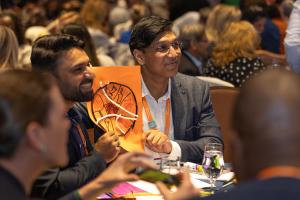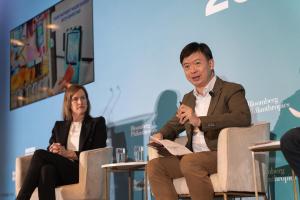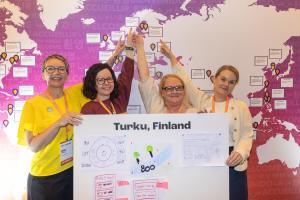 Read More
Read More
How to transform a core city service

Listen to This Article
Local leaders sometimes look to innovation as a way to add value for residents without significantly shaking up basic service delivery. But some of the most valuable innovations happen when cities take a fresh look at those very services, such as sanitation, education, or housing. While these essentials may seem routine, improving them can significantly raise the quality of people’s everyday lives and help cities stay ahead of future problems.
That’s why Bloomberg Philanthropies focused its 2025 Mayors Challenge on uncovering new ways to deliver essential city services. And it’s why 200 local leaders from the Challenge’s 50 finalist cities (selected from more than 630 applications and hailing from 33 countries) recently came together in Bogotá for an Ideas Camp designed to stretch their ambition, fine-tune their ideas, and show them what it takes to transform a core city service.
Ultimately, only 25 of these cities will be awarded $1 million and technical assistance to bring their winning solutions to life. But already, their work is producing insights about what becomes possible when cities start with a foundation of bold mayoral vision, test ideas aggressively, and then work to win the hearts and minds of residents for change.
Bringing bold ideas to sensitive terrain.
Civil servants can, understandably, be hesitant to experiment with core services. People depend on their sustained delivery and, if and when something gets in the way of that delivery, it could further erode trust in government. That’s why it’s critical that mayors use their vision to create space for teams to take calculated risks in these sensitive areas.
At Ideas Camp, leaders heard from Enrique Peñalosa, the two-time mayor of Bogotá, about how he did just that.
When he led the city (from 1998-2001 and again from 2016-2019), Peñalosa was constantly on the lookout for what were, at the time, cutting-edge ways to innovate core city services in order to bring his vision of a more equal city to life. It’s a vision that he conveyed to his team by setting clear, measurable goals, such as better experiences for pedestrians in a car-dominated city. And he took bold action to achieve them, including restricting car use on Sundays and raising fuel taxes to help pay for new, pedestrian-friendly infrastructure.
There were risks: As Peñalosa told the group in Bogotá, his reforms faced significant blowback (such as a taxi- and bus-driver strike that disrupted daily life). But the former mayor likes to say his vision had “teeth," by which he means it pointed to a clear end-game that served as a guide when setbacks arose: a city where residents of different incomes are on equal footing in public spaces. That clarity and consistency helped his team push ahead on what became signature wins, such as the Transmilenio Bus Rapid Transit (BRT) system, which has since revolutionized city transit worldwide.
At Ideas Camp, mayoral vision was already positioning city teams to embrace risk-taking that can produce essential service breakthroughs.
Take Toronto. Mayor Olivia Chow has a vision of making nutritious food available to all of the city’s schoolkids, a decades-old priority going back to when she helped launch a program providing morning meals in some city schools. Now, her city’s Mayors Challenge idea is geared at expanding that program city-wide, and, critically, using bulk purchasing to make those meals more nutritious, support local suppliers, and ultimately reshape the larger food market in the city.
The Toronto team’s work is still very much in its early stages. And it’s risky—not only because sourcing the food that goes into kids’ mouths every day carries inherent sensitivity, but because of the potential for the public to view new spending (as this work calls for) as wasteful. Yet knowing where the mayor stands and her willingness to invest political capital in the effort has encouraged the team to move forward quickly.
“The risks she’s taking with her ideas have emboldened us,” explains Bryony Halpin, a manager in the city’s poverty reduction office.
Testing and learning on a whole new level.
Mayoral vision is the critical foundation for transforming core services that are, ultimately, mayoral responsibilities. But according to Aparna Ramanan, who leads the Mayors Challenge at Bloomberg Philanthropies and guided city teams through their work at Ideas Camp, to bring big changes to such essential services, “Mayors need their teams to test every assumption they have early in the process, rather than just mock up many versions of a possible solution.” They also need to pilot and measure with special care. And Ideas Camp presented teams with the opportunity to think through together how to best go about that work.
For example, in Kyiv, the city is working to integrate AI to personalize career and mental-health services on the city’s digital education platform. The team knows they have to test everything from the look and feel of the tools that help youth identify possible career paths to how those career options will be presented to them. One assumption they’ve already abandoned after early testing is that young people might want this service to be fun, or playful. Instead, they want to be treated seriously—as adults charting their future.
With support from seasoned city leaders and innovation coaches, the teams at Ideas Camp also wrestled with what to measure to test the efficacy of their proposed solutions. In some pilot projects, usage and satisfaction may be the most critical indicators for success—for instance, when testing a new bus line to see if it will be used. But they’re not always the right metrics to look at. For example, Benin City, Nigeria, is working to launch new public-health kiosks to improve women’s health. As Lane Dilg, a former Santa Monica, Calif., city manager and until recently head of partnerships at OpenAI, reminded the teams at Ideas Camp, in cases like this, success depends on whether the service changes the underlying behavior it’s meant to address. For Benin City, that means reducing unintended pregnancies. Measuring that kind of impact may require following up with users over time to understand how outcomes evolve.
Telling stories to soften the ground for change.
Even when they’re born of mayoral vision and carefully tested, bold ideas need broad support to become embedded in core service delivery. At Ideas Camp, cities learned that means building coalitions geared at overcoming resistance to change.
As James Anderson, who leads the Government Innovation program at Bloomberg Philanthropies, told Ideas Camp attendees, “Innovation rarely has natural champions, but the existing system and the status quo definitely do.”
That reality makes communication (and, specifically, creating urgency) all the more critical, both inside and outside city hall. And it’s a lesson that the 200 Ideas Campers took to heart as they fine-tuned their narratives of change, even pitching their colleagues to get a sense of how their evolving stories resonated in real time.
For example, in Marseille, where the city is working to provide housing for at-risk women, the team decided to emphasize the case of Gisèle Pelicot, the sexual-assault survivor whose case sparked global outrage and who has become a prominent advocate. This underscores that this new solution isn’t just necessary—it’s the right thing to do. And while data can be a powerful storytelling device, the pitching process showed the Barcelona team that their approach was actually too data-intensive. Their Mayors Challenge idea is to rehabilitate housing city-wide to prevent heat-related deaths and lung damage to children caused by mold, and one priority is convincing the owners in any given building to align on repairs. That requires an emotional communications effort, not just a statistical one.
As Anderson explained, at a moment of low trust, it’s critical for cities to define themselves and their work proactively in residents’ eyes. And the very act of prototyping can help them demonstrate tangible effort and progress on core priorities.
“The innovation process is filled with opportunities to tell people what your values are,” Anderson told assembled leaders, “and disrupt their idea of what a bureaucracy does.”



